Assignment #3 Solutions
Due in Math Main Office at 3:50pm, Friday, Feb 24.
2.3
2.3.X
a. Make a plot of the solution of the heat equation for a laterally insulated copper bar of length 0.6 meters (2 ft), whose ends are maintained at 0 degrees, and whose entire interior is initially at 100 degrees. Show only snapshots for t = 10, 60, 360 seconds. For your approximation, include terms of the series for n up to M = 100.
Recall that the computation I did in class assumed k = 1, which is not the case here.
[1pt code turned in]
[4pts modifications correct in first 4 lines of code below]
L = 0.6 # length of bar in meters M = 100 # max n k = 1.11e-4 # thermal diffusivity of copper (OK if a bit different - varies with temperature and type) tvalues = [10,60,360] # times of snapshots x = linspace(0,L,201) n = arange(1,M+1) B = 200*(1-cos(n*pi))/(n*pi) for t in tvalues: Q = (B*sin(outer(x,n)*pi/L))*exp(-(n*pi/L)**2*k*t) u = Q.sum(axis=1) plot(x,u,alpha=0.5,label='t='+str(t)) xlabel('x') ylabel('u(x,t)') legend(loc='lower center');
[2pts image turned in]
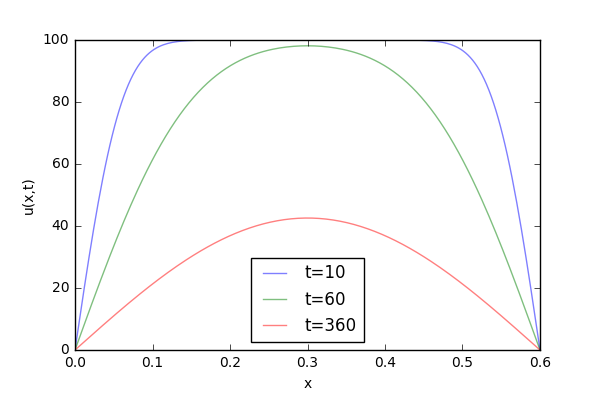
- Run your code again for the case where the bar is stainless steel ("310") rather than copper.
[1pt for ok value of k]
L = 0.6 # length of bar in meters M = 100 # max n k = 4.2e-6 # thermal diffusivity of stainless steel 310 (OK if a bit different - varies with temperature and type) tvalues = [10,60,360] # times of snapshots x = linspace(0,L,201) n = arange(1,M+1) B = 200*(1-cos(n*pi))/(n*pi) for t in [10,60,360]: Q = (B*sin(outer(x,n)*pi/L))*exp(-(n*pi/L)**2*k*t) u = Q.sum(axis=1) plot(x,u,alpha=0.5,label=str(t)) xlabel('x') ylabel('u(x,t)') legend(loc='lower center') savefig('2.3.Xb.png');
[2pts image turned in]
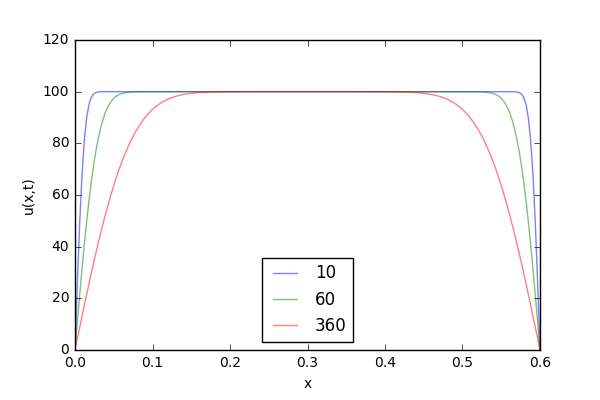
Comment on the difference. [2pts]
Wow! Stainless steel conducts heat very poorly compared to copper! That explains why there are stainless steel pans with a copper bottom to distribute the heat from the flames:
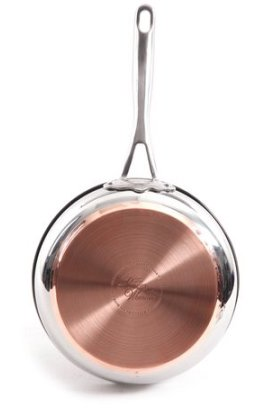
c. How long does it take for the temperature at the middle of the bar drop "noticeably" below 100 degrees? (Both materials.) I intend that you do this simply by re-running the code you used for parts a and b for various t-values that you choose by trial and error. This is an imprecisely posed question: any reasonable interpretation acceptable.
I will just use the same code as for (a) and (b) and fiddle with the t-value ... Answer: For copper, at around 50 seconds you can start to see a gap between the curve and the top of the plot.
[2pts for correct answer for copper]
[2pts for support of answer, such as a plot like the one below]
L = 0.6 # length of bar in meters M = 100 # max n k = 1.11e-4 # thermal diffusivity of copper (OK if a bit different - varies with temperature and type) tvalues = [50] # times of snapshots x = linspace(0,L,201) n = arange(1,M+1) B = 200*(1-cos(n*pi))/(n*pi) for t in tvalues: Q = (B*sin(outer(x,n)*pi/L))*exp(-(n*pi/L)**2*k*t) u = Q.sum(axis=1) plot(x,u,alpha=0.5,label='t='+str(t)+' secs') xlabel('x') ylabel('u(x,t)') legend(loc='center') savefig('2.3.Xci.png');
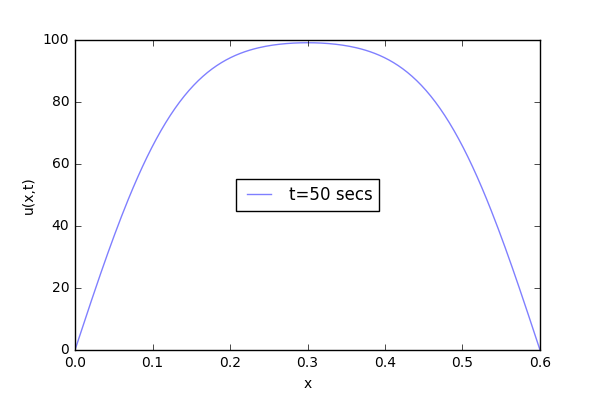
[1pt for correct answer for stainless steel]
For stainless steel, you have to wait about 22 minutes! before you start to see a drop in temperature at the midpoint!
[1pt for support of answer for stainless steel]
L = 0.6 # length of bar in meters M = 100 # max n k = 4.2e-6 # thermal diffusivity of copper (OK if a bit different - varies with temperature and type) tvalues = [22*60] # times of snapshots x = linspace(0,L,201) n = arange(1,M+1) B = 200*(1-cos(n*pi))/(n*pi) for t in tvalues: Q = (B*sin(outer(x,n)*pi/L))*exp(-(n*pi/L)**2*k*t) u = Q.sum(axis=1) plot(x,u,alpha=0.5,label='t='+str(t)+' secs') xlabel('x') ylabel('u(x,t)') legend(loc='center'); savefig('2.3.Xcii.png');

Make a plot of the temperature at the mid-point versus time. [Extra credit 4pts]
# copper L = 0.6 M = 100 k = 1.11e-4 # thermal diffusivity of copper #4.2e-6 # thermal diffusivity of stainless steel 310 x = L/2 n = arange(1,M+1) B = 200*(1-cos(n*pi))/(n*pi) t = linspace(10,50000,100) t = linspace(10,100,100) spacepart = B*sin(n*pi*x/L) timepart = exp(-outer(k*t,(n*pi/L)**2)) spacepart.shape,timepart.shape Q = spacepart*timepart u = Q.sum(axis=1) #print(Q) plot(t,u,alpha=0.5,lw=2,clip_on=False) xlabel('t (seconds)') ylabel('u(L/2,t)') title('copper'); # copper and stainless steel together L=0.6 M = 100 x = L/2 tarray = linspace(10,3600,300) k = 1.11e-4 # thermal diffusivity of copper u = [sum([200*(1-cos(n*pi))/(n*pi)*sin(n*pi*x/L)*exp(-(n*pi/L)**2*k*t) for n in range(1,M+1)]) for t in tarray] plot(tarray,u,alpha=0.75,lw=2,clip_on=False,label='copper') k = 4.2e-6 # thermal diffusivity of stainless steel 310 u = [sum([200*(1-cos(n*pi))/(n*pi)*sin(n*pi*x/L)*exp(-(n*pi/L)**2*k*t) for n in range(1,M+1)]) for t in tarray] plot(tarray,u,alpha=0.75,lw=2,clip_on=False,label='stainless steel') xlabel('t (seconds)') ylabel('u(L/2,t)') legend(loc='center right') savefig('2.3.Xcxii.png');
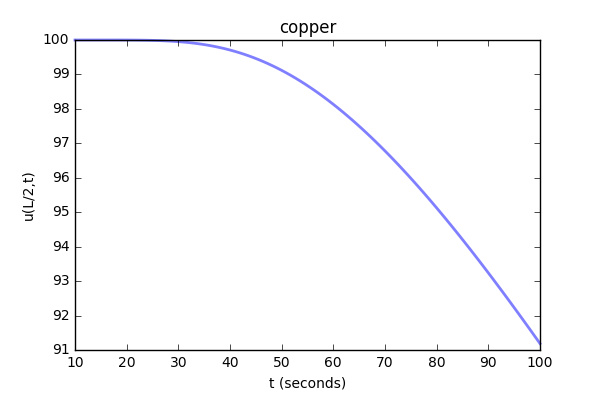
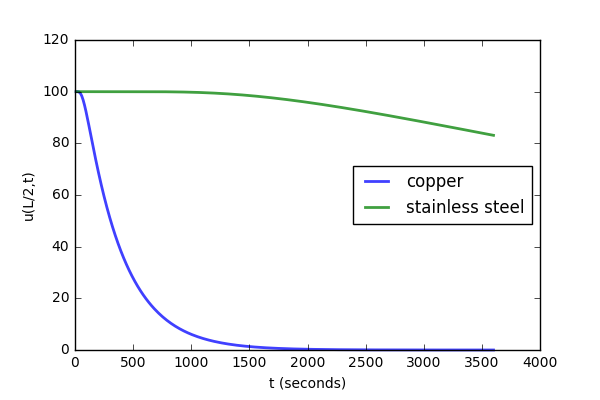
2.5
2.5.X
a. Solve Laplace's equation on the rectangle 0 ≤ x ≤ 2 0 ≤ y ≤ 3 with u = 0 on the boundary except for the side with x = 0 where u(0, y) = sin(πy).
[5pts]
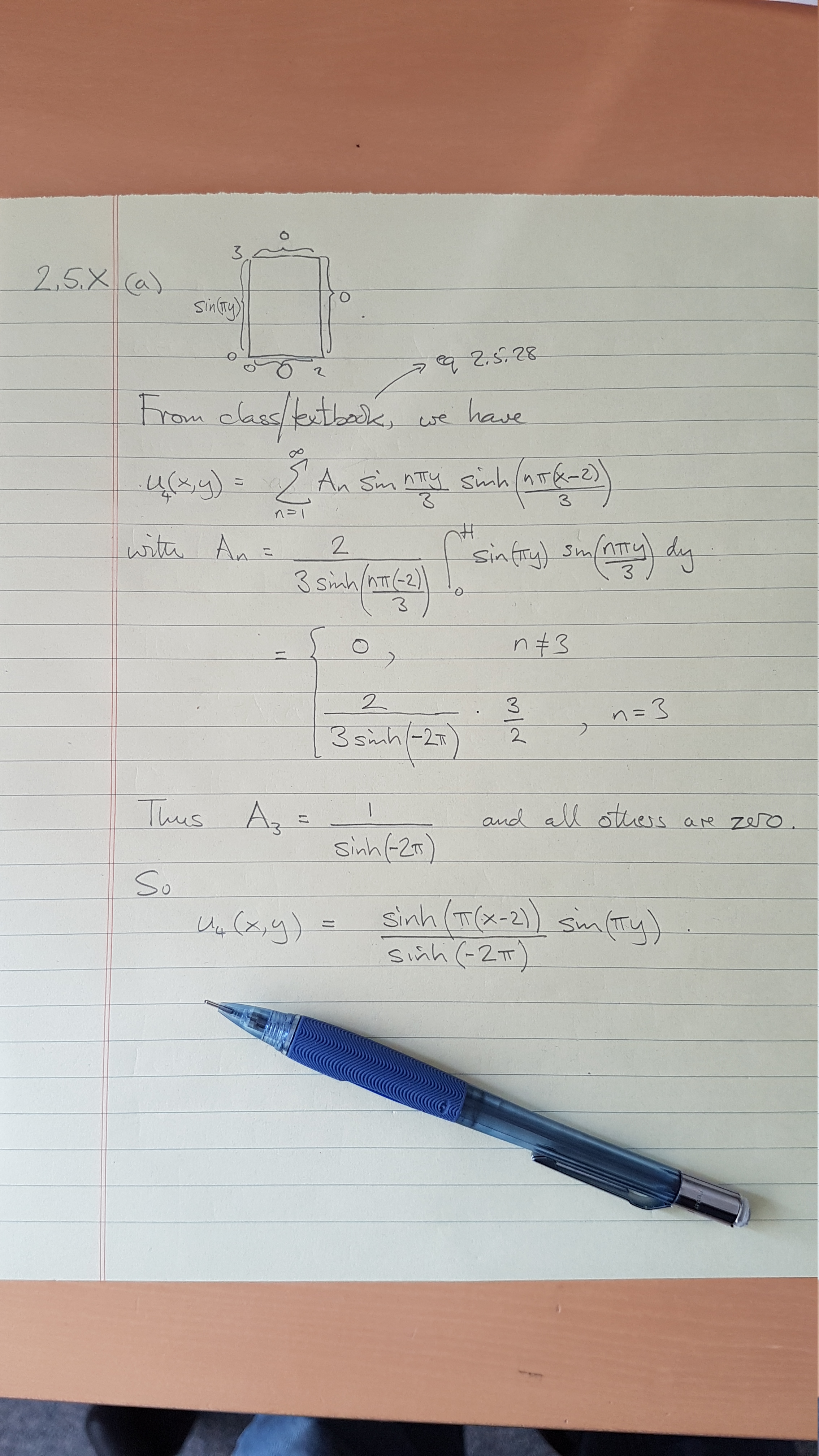
b. Make a picture of your solution by slightly modifying the following code:
[4 points for turning in code with correct modifications to 4 lines with #####]
from numpy import * %matplotlib inline from matplotlib.pyplot import imshow, savefig, colorbar xmin,xmax = 0,2 #### x boundary values ymin,ymax = 0,3 #### y boundary values nx,ny = 200,300 #### number of points should be in proportion to length of axes x,y = meshgrid( linspace(xmin,xmax,nx), linspace(ymin,ymax,ny) ) u = sinh(3*pi*(x-2)/3)/sinh(3*pi*(0-2)/3)*sin(3*pi*y/3) ######## this is the solution # or, more simply, u = sinh(pi*(x-2))/sinh(-2*pi)*sin(pi*y) imshow(flipud(u),interpolation='bilinear',cmap='bwr',extent=[xmin,xmax,ymin,ymax]) colorbar() savefig('2.5.Xb.png')
[2pts for turning in correct image]
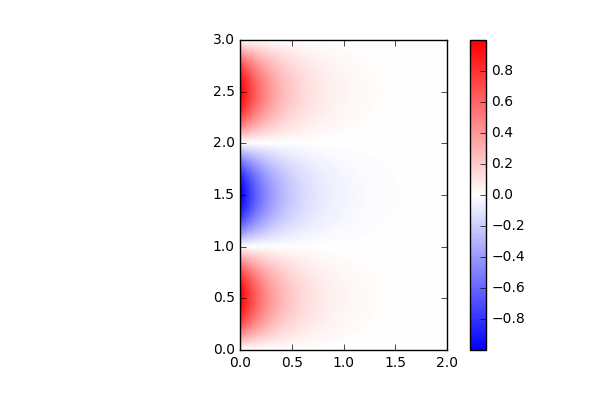
2.5.Y
Solve Laplace's equation for u(r, θ) on the quarter-disk 0 < r < a, 0 < θ < (π)/(2) subject to boundary conditions u(a, θ) = g(θ) and no normal flux on the straight sides (θ = 0 and θ = (π)/(2)). I will show you a similar problem in class on Thursday.
[6 pts]
